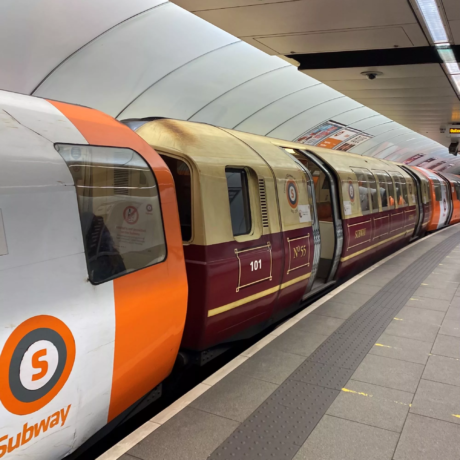
Los Angeles is arguably in the midst of an artistic renaissance. Once a historically underserved city in the realm of art-world bureaucracy, L.A. has quickly become an international hub for galleries and collectors over the last decade. This reality, in tandem with the rich and historically overlooked artistic traditions of Southern California, is making L.A. an ever-evolving, world-class arts destination. It only made sense then when Frieze hosted its first L.A. art fair in 2019, which has quickly become a foundational part of the L.A. art scene’s calendar.
This year, to accentuate Frieze’s relationship to the city, the fair has selected the curator of the California African American Museum in Los Angeles, Essence Harden, to put together its Focus section. Harden’s curation for the fair is “rooted in community, place and ideas of ecology.” For Focus she has selected twelve galleries, nine of which are in California.
Below, Elephant writer Theo Meranze explores the best of Frieze LA, 2024.
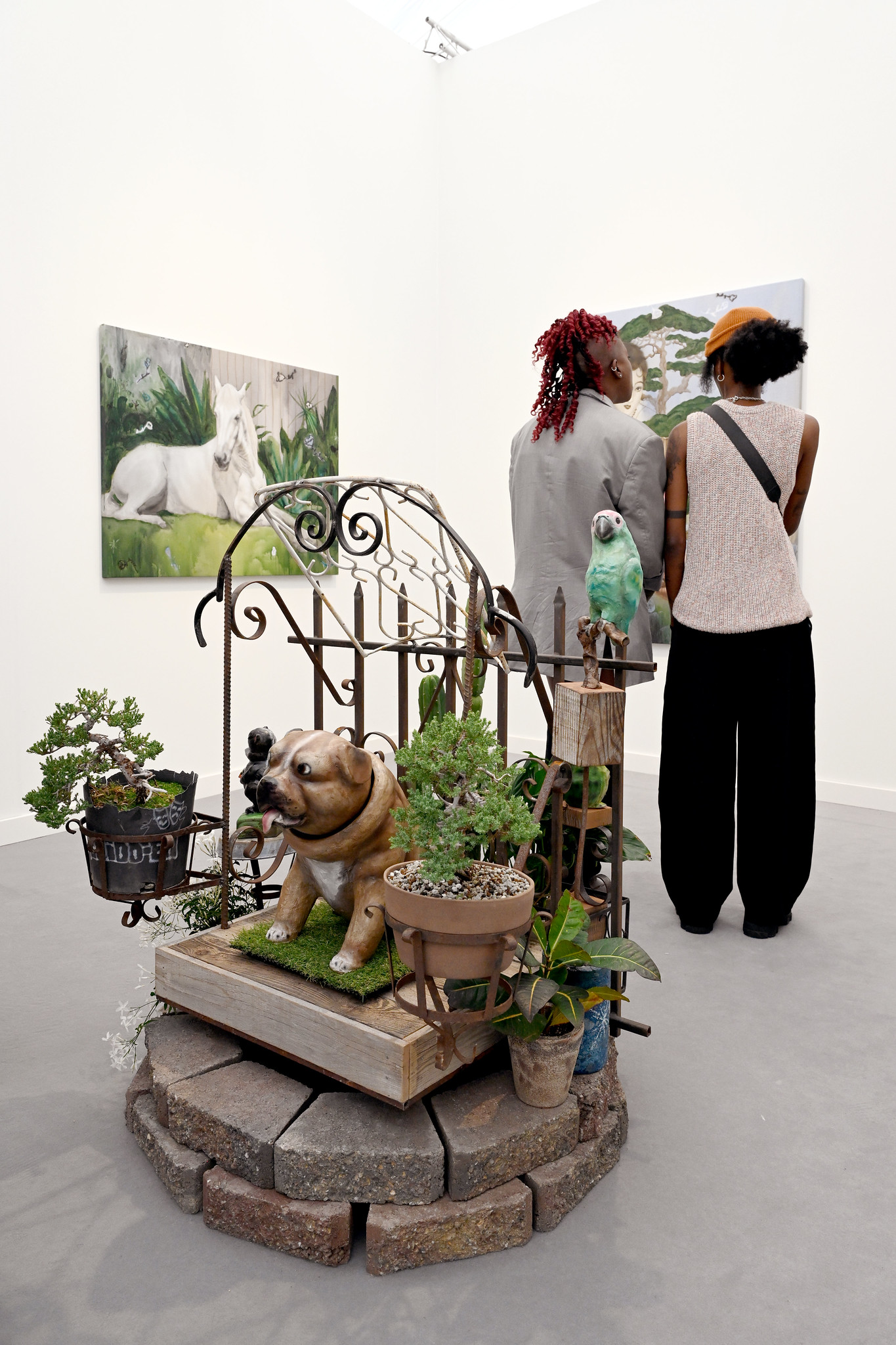
Javier Ramirez at Sow & Tailor
Sow & Tailor is as Los Angeles as it gets. Founded in 2021 by L.A. native Karen Galloway, the south central gallery has made its mission to highlight typically overlooked Southern Californian artists. While in many ways a new kid on the block, Sow & Tailor’s influence and impressive curatorial prowess has made it one of L.A.’s most important burgeoning art spaces.
Fittingly, for its second go at Frieze L.A. as a part of the Focus section, the gallery is showing the work of Los Angeles native Javier Ramirez. Ramirez’s work excavates the connections between Southern California’s Japanese and Latino communities, specifically their relationship to migrant labor. The intersecting histories and aesthetics of these two groups are indelible parts of the region’s past, and by extension, its present. Ramirez ceremonializes this reality by approaching them with cerebral hands, melding them into acrylic, graphite, and marker based paintings and a multi-material sculpture. The artist’s work feels subtly mystical yet remarkably grounded, nostalgic without being fetishistic: his pieces pull you in and tell you Californian folktales.

Blessing Ngobeni at Jenkins Johnson
A champion of curators and collectors of color, Jenkins Johnson has been platforming biting, lucidly political work since its founding in 1996. With two locations, one in Brooklyn and the other in San Francisco, the gallery has established itself a strong track record during its nearly two decade long existence. In the first Los Angeles solo showing of his career, South African multi material collage artist Blessing Ngobeni fits well into its canon.
Ngobeni’s booth at Frieze explores the fraught realities of post-apartheid life in his home country. Utilizing imagery inspired and taken from South African media, his multi-layered pieces function as social critique and historiography: their subtle, abstracted bodies containing the imagistic and material pillars of his society’s marred unconscious. His use of a diverse array of material is particularly notable, weaving tactile fibers and fabrics in his work as a means of accentuating their relationship to the stories and realities he is reflecting on in his work. In an interview conducted in 2020 and published in Iliso Magazine, Ngobeni refers to himself as a “visual dancer.” It’s easy to see why— there is a striking movement to his work, one that Pirouettes through time and place with a sharp historical perspective.
Wildline Cadet at Shulamit Nazarian
Shulamit Nazarian is a Los Angeles based gallerist who has historically made it her mission to platform emerging and mid-career artists, specializing in Middle Eastern art. She initially established herself in a Venice, CA home in 2011, before moving to a more traditional gallery space in 2017 off of La-Brea and Melrose in Hollywood. Since this move, Nazarian has continued to prove herself an integral part of the city’s artistic ecosystem.
Historically unafraid of politically inclined work, Zazarian’s bold curatorial prowess has helped make the gallery a growing force in the L.A. art-world. For her showing at Frieze this year in the Focus section, she’s putting on a solo presentation by Haitian multimedia artist Widline Cadet, who is set to put on a full exhibition with Nazarian later in the year. Cadet’s Frieze presentation consists mainly of self- referential photographs and videos which draw from her journey as a Haitian immigrant in the United States. The artist at times integrates video into her photographic displays, allowing her to play with notions of time and photographic presentation. Her fleeting, multimedia memory-scapes and stunning portraiture are the site of a deeper examination of Haitian cultural identity, specifically as it relates to dynamics of race and immigration in the United States.
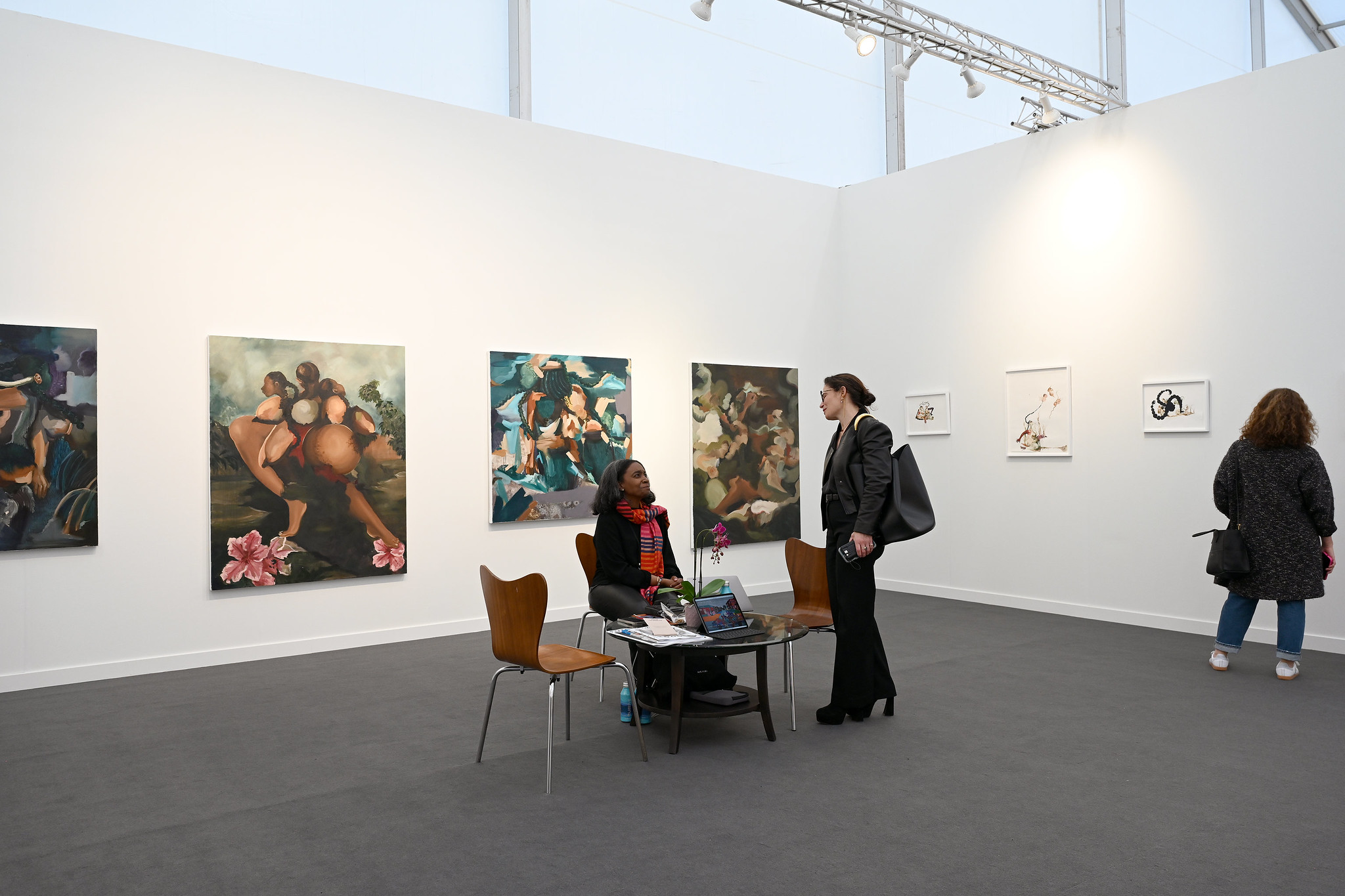
Debra Cartwright at Welancora
Brooklyn’s Welancora Gallery is based out of a 19th century townhouse in Bed-Stuy, but its reach is world-wide. Founded two decades ago with the goal of platforming the art of the African diaspora, Welancora has become a force to be reckoned with while staying true to its physical and intellectual roots. At Frieze L.A. it’s showing the work of Debra Cartwright, a multi-medium artist whose paintings and mixed media compositions explore the relationship between black women and the American medical system.
Cartwright, a black woman and daughter of a gynecologist herself, mythologizes the body through her use of subtle abstraction. The dampened bodies in Cartwright’s work are universes unto themselves, often spread throughout the canvas and composed of a myriad of forms and beings themselves. Her pieces are poignantly dreamlike, yet by no means do they run from the world. There is a pained reverence that sprouts from Cartwright’s style, one that simultaneously memorializes and laments the fraught histories of racial and gender struggle she is processing through it.

Sam McKinniss at David Kordansky
David Kordansky has become a pillar of the L.A. art scene in his two decades and running as a gallerist. Spreading his wings from L.A’s Chinatown in 2003 to the corner of La Brea & Edgewood and now a location in Chelsea, New York, Kordansky has been an integral part of the movement to prove that you can turn an L.A based gallery into an international force in the art-world.
For Kordansky’s presentation at Frieze L.A this year, he’s showing the work of New York based painter Sam McKinniss. McKiniss crafts figurative pop-culture portraiture that depicts American celebrity with an uneasy hue. Not only is McKiniss an astounding painter, but his precise choice of subject and style has a powerful social resonance in an era defined simultaneously by social instability and celebrity worship.
The famous subjects of McKiniss’s paintings often look subtly warped, disturbed, and red eyed. His painting of Halle Berry as Jinx Johnson in James Bond, which is being exhibited at Frieze, is a prime example. In a sense the painter is humanizing his subjects through unveiling the oppressive reality their commercialized image embodies. In this way his work contains within it a revelatory nature, mining the images that surround us for their hidden messaging.
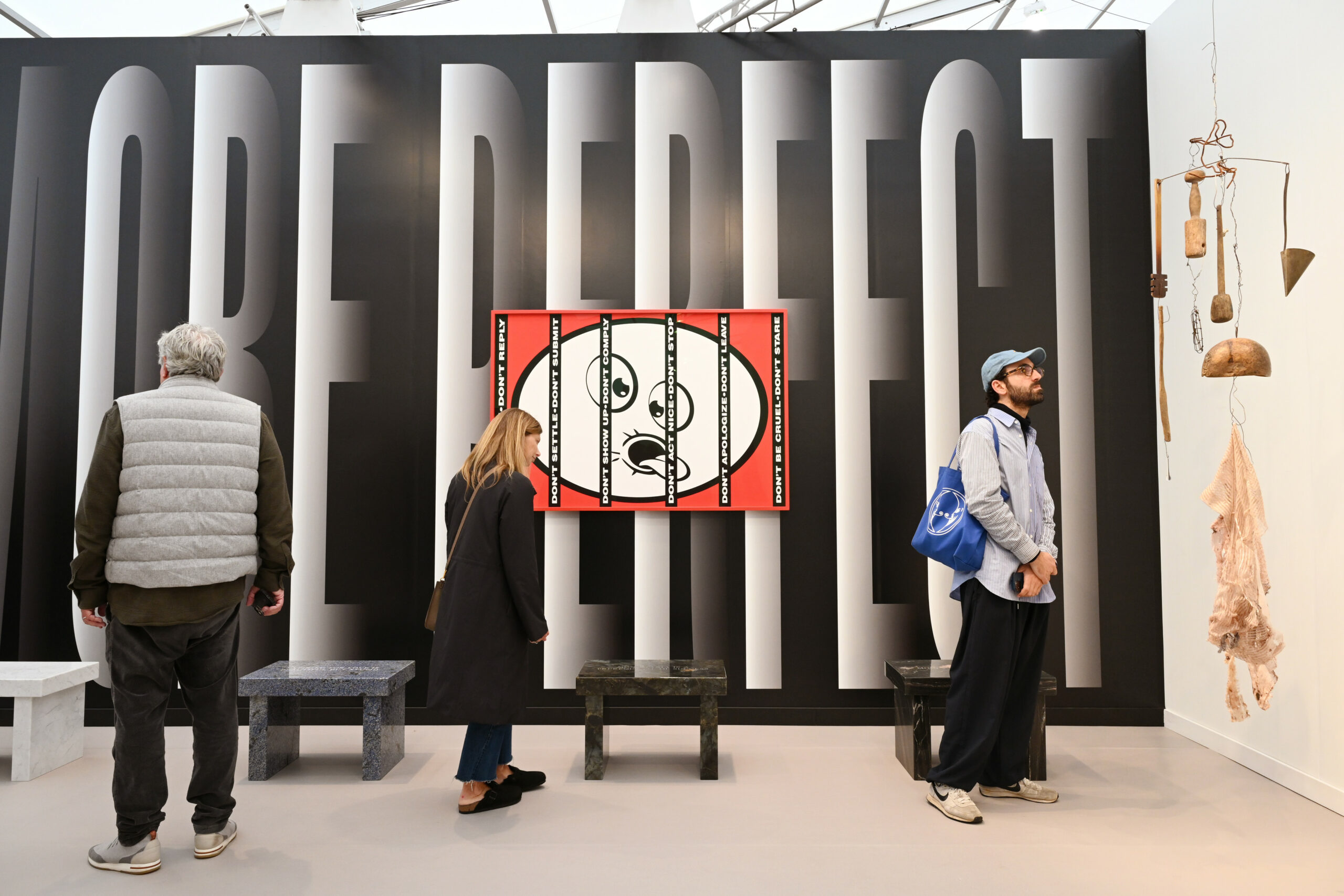
Barbara Kruger, Louise Lawler, Jenny Holzer George Condo, and many others at Sprüth Magers.
Founded in Cologne in 1983 by Monika Sprüth and Philomene Magers with the aim of platforming groundbreaking contemporary art, particularly the work of female artists, the now historical Sprüth Magers is one of the most important art-spaces in the world. An international powerhouse, the gallery now has locations in Berlin, Los Angeles, London, and New York, as well as offices in Hong Kong, Seoul, and London.
Staying true to its original ethos, at Frieze L.A. this year Sprüth Magers is showing the work of some of the most important artists of the last half a century. To attempt to describe the swath of work being presented at Frieze in a few sentences would be impossible. Barbara Kruger is exhibiting new wall-work. Louise Lawler is showing photographs that depict Jenny Holzer’s work pre installation at their collaborative 2007 show. Jenny Holzer herself is showing benches and stools that include phrases from her series, Truisms. The legendary George Condo is showing his painting Old Man Portrait. Gretchen Bender is showing video work. The list goes on: Rosemarie Trockel, John Baldessari, Karari Upson, Sterling Ruby, Robert Irwin, Senga Nengudi, Anne Imhof, Nora Turato, Martine Syms, Analia Saban, Astrid Klein, and Pamela Rosekranz, are all exhibiting with Sprüth Magers.
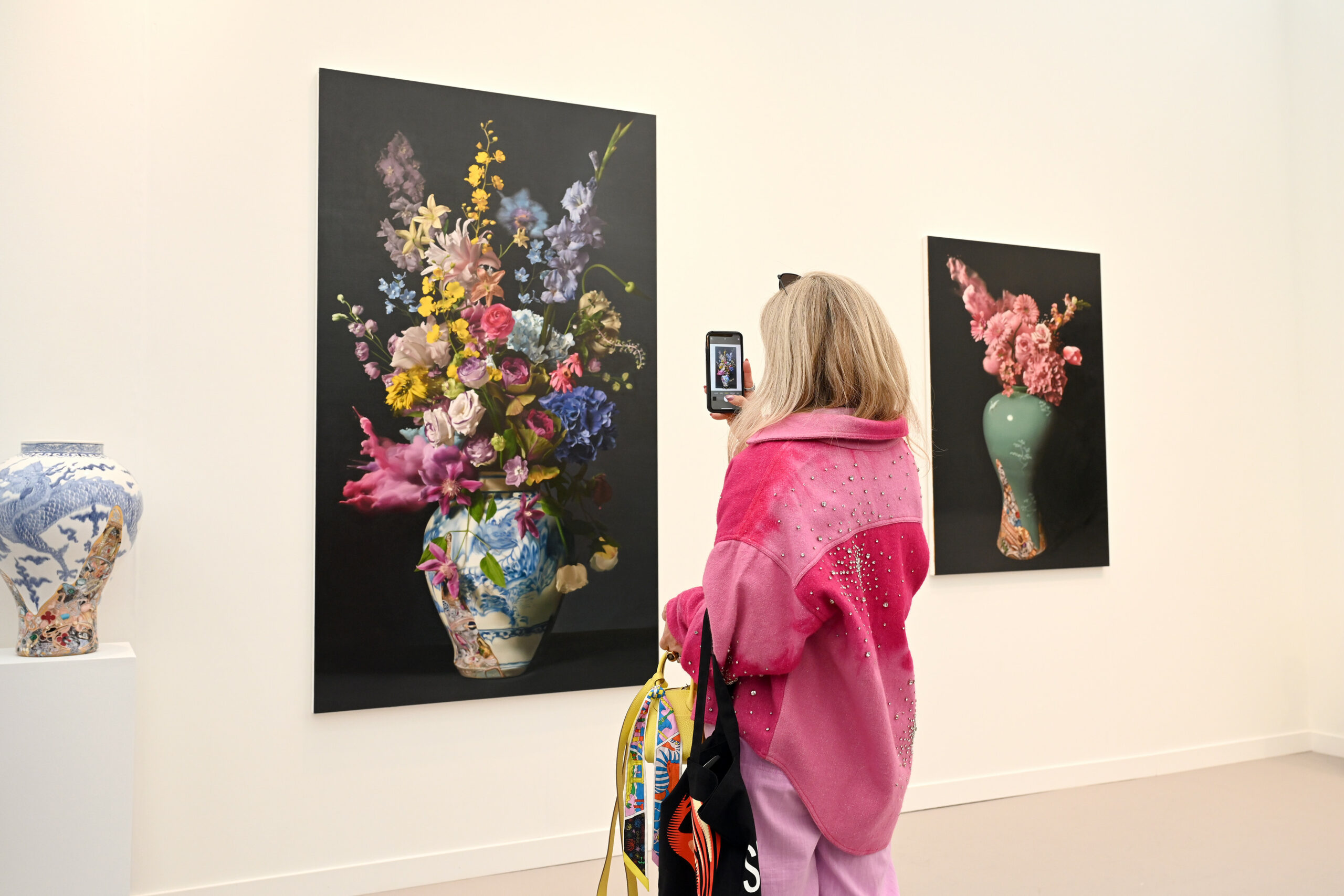
Kim Sung Yoon collaboratively with Yoo Eui Jeong at Gallery Hyundai
The oldest gallery in Korea, Gallery Hyundai has been instrumental in developing the contemporary landscape of Korean art. Since its founding in 1970, Hyundai has hosted some of the most important exhibitions in Korean art-history and facilitated the careers of the country’s most storied artists, such as Nam June Paik, considered to be the founder of video art, and the world renowned painter Lee Ufan.
For its showing at Frieze L.A, Gallery Hyundai is presenting the collaborative and individual works of Korean painter Kim Sung Yoon and the ceramicist Yoo Eui Jeong. A prodigal painter with a well cultivated historical perspective, Yoon’s work employs an extremely impressive, classical technique to paint his flower-centric pieces with a contemporary diction. Yoon uses Jeong’s detailed and at times mythical vases in all of his paintings at Frieze. Joeng’s vases are also being shown alongside the paintings in the booth.
Yoons other greatest collaborator, in many ways, is the digital archive. In a recent interview with Harper’s Bazaar, Yoon explains he often jokes that he’s “an artist striving to merge the online and offline.” The images in his paintings are often arranged digitally and drawn from google searches as well as in person forays into flower markets. His flowers and vases in his booth at Frieze are oftentimes subtly evaporating, exploding or falling apart, though this motif feels hushed. There is a pristine humbleness to his work: he does not flaunt his underlying experimentation and technical prowess. Still, it’s certainly felt.
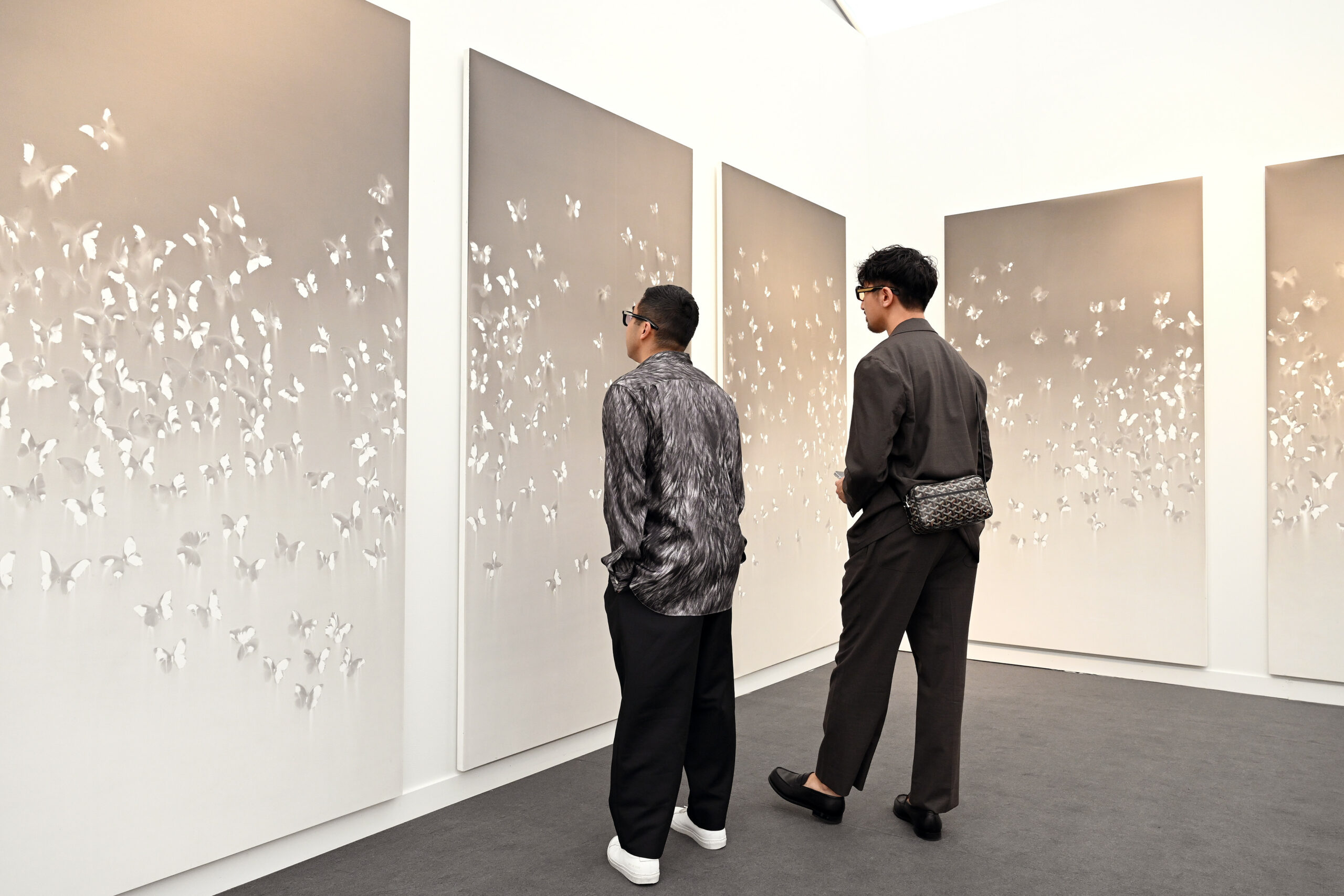
Claudio Parmiggiani at Bortolami
Bortolami, the brain child of Stefania Bortolami and Amalia Dayan, the latter of whom directed the canonical Gagosian Gallery for a number of years, has cultivated a strong presence in New York’s art- world over the last two decades. At Frieze, Bortolami is showing works of the well-accomplished and canonical Italian post-war artist Claudio Parmiggiani from his “Delocazione” series. “Delocazione” literally translates to “delocation,” and it makes sense. Parmiggiani’s panels are marked with the ghostly soot traces of intentionally set fires— they pierce you through their haunting deployment of absence. The largest work being shown at Frieze, a multi-panel collection of butterfly wings, felt particularly profound.
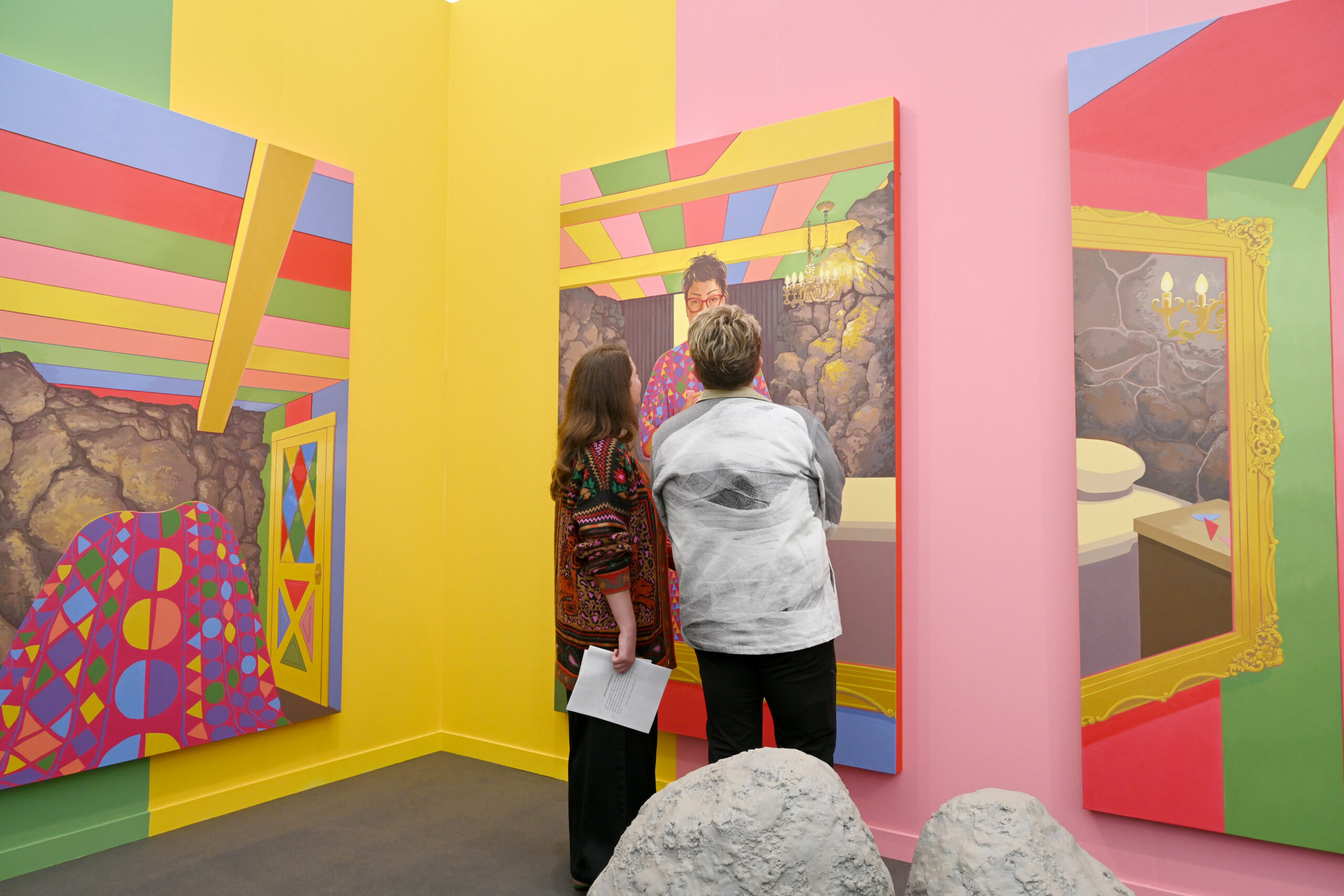
Stephanie Syjuco and Jenifer K. Wofford at Silverlens
Silverlens is an Italian gallery with roots in the coastal city of Manila. In 2022, it opened a New York location in Chelsea, establishing itself as an international art-space. For its first presentation at Frieze L.A. Silverlens is showing the work of two Filipino American artists, mixed media artist Stephanie Syjuco and painter Jenifer K. Wofford. Wofford’s paintings are from her Comfort Room series, which explores San Luis Obisbo’s Madonna Inn, a central California landmark known for its themed rooms and ongoing pop-cultural relevance. Syjuco’s handmade, photograph based collages are similar in that they are also a meditation on a kind of archive. They are rooted in images from the since passed Filipino newspaper, the Manila Chronicle and represent an attempt by the artist to convey the movement of history, specifically in the context of a history of political struggle in the midst of its erasure.
Gregor Hildebrandt at Perrotin
Emmanuel Perrotin has been in the gallery world since his early twenties. He founded his first gallery in 1990, and in the last three decades he’s established an international powerhouse under his name with locations in Paris, New York, Hong Kong, Seoul, Tokyo, Shanghai, and as of Frieze week in L.A., a new gallery in the mid-city neighborhood of Los Angeles.
To celebrate, Perrotin is showing a solo presentation of the work of German multi-medium artist Gregor Hildebrandt at Frieze (alongside the select works of other Perrotin artists.) Hildebrandt’s work is all about media and pop culture. In his body of work being shown at the fair, he’s memorializing the film All About My Mother by Spanish director Pedro Almodóvar.
Hildebrandt’s practice is incredibly unique. He utilizes ever-fossilizing analog media technology to explore our relationship to cinema and media at large. For his showing at the fair, Hildebrandt presented sculptural columns made from old vinyl records and striking portraits of female characters from All About My Mother on the back of old cassette tapes. The artist’s signature “rip off” paintings, which use the magnetic coating of audio and video tape to create positive and negative impressions on dual canvases. In the ever-changing techno-landscape of the 21st century, Hildebrandt’s practice feels particularly relevant.
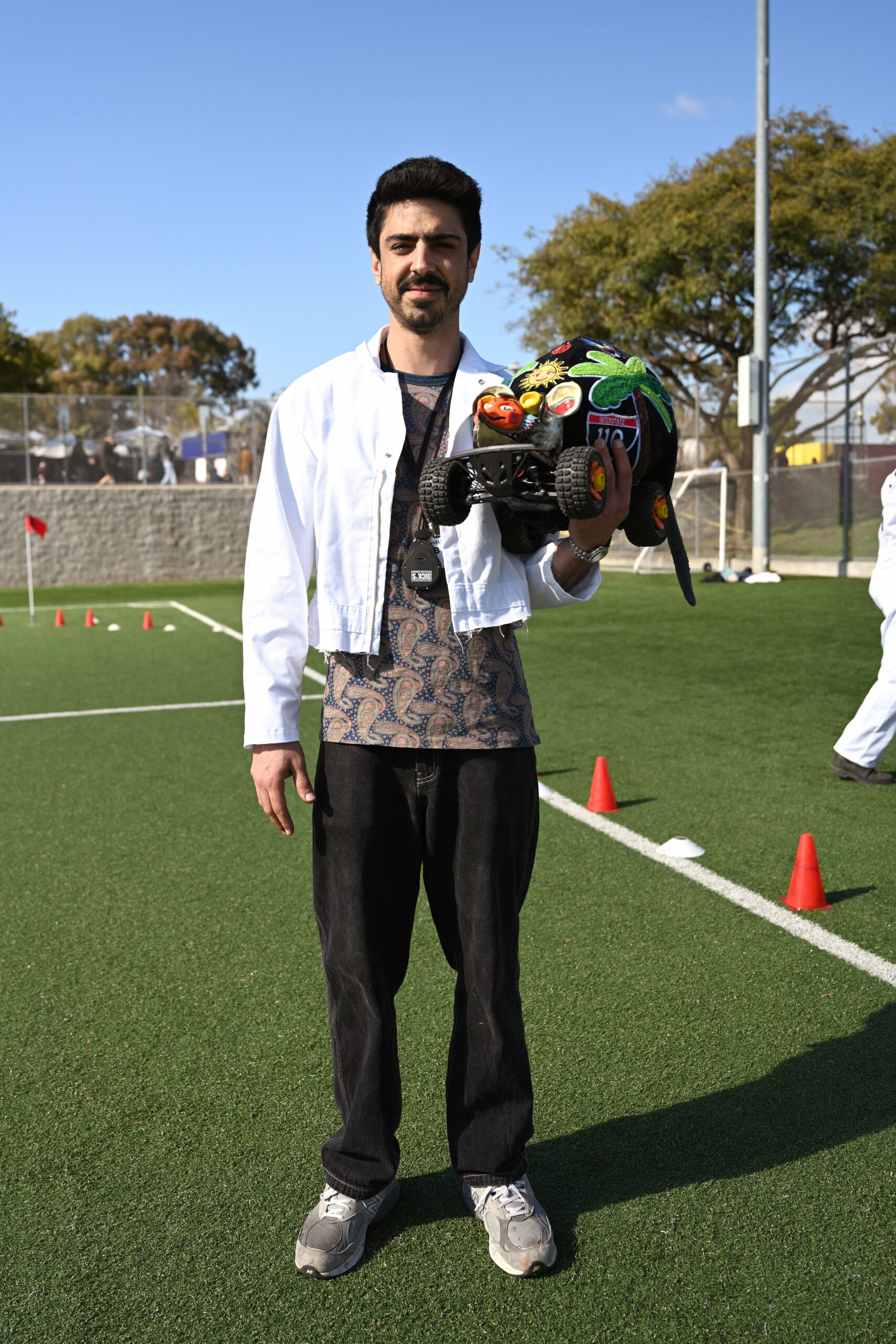
Sharif Farrag, Rat Race, 2024
A born and raised angeleno and graduate of UCLA’s prestigious MFA program, ceramicist and multimedia artist Sharif Farrag is one of the most important young names in the L.A. art-world. Fittingly, Farrag was one of the artists chosen by Art Production Fund, who’s returning this year to curate their for-the-public Set-Scene series at Frieze L.A. This year, Set-Scene aims to “feature works drawing on constructed environments and how they relate to the perception of reality and space.”
Farrag’s project Rat Race is a commentary on the car’s relationship to capitalism in Southern California. Los Angeles is a city where a car may as well be as important as one’s legs, a sprawling metropolis of former suburbs where the typical experience of 20th century urban centers: walkability and mass-transit, is replaced with a complex web of freeways and a constant need to drive. Through the crafting of ceramically adorned, rat-headed R/C cars, Farrag conveys how for the average working resident of Los Angeles the act of driving can come to embody the mindless and exploitative reality of work at large. Farrag is also putting together races on Santa Monica Airport’s sports field throughout the weekend, which are meant to allegorically invoke the competitive marketplace dynamics of neoliberal life.
Pippa Garner, Haulin’ Ass!, 2023

Iconic artist, illustrator, and writer Pippa Garner is having a piece shown at Frieze, but with a fun twist. Garner moved from Detroit to California in the late 1950s when the city was the opulent hub of the automobile industry. This relationship to cars became a notable throughline of her multifaceted art practice and investment in the absurd.
For Frieze L.A., Garner’s 1974 Backwards Car, which was at the time profiled in Esquire magazine, a custom 1959 Chevy which is, quite literally, rotated backwards, now has its own nut-sack. The car, along with its testicles, will be driven around the fairgrounds over the duration of the weekend.
Written by Theo Meranze


